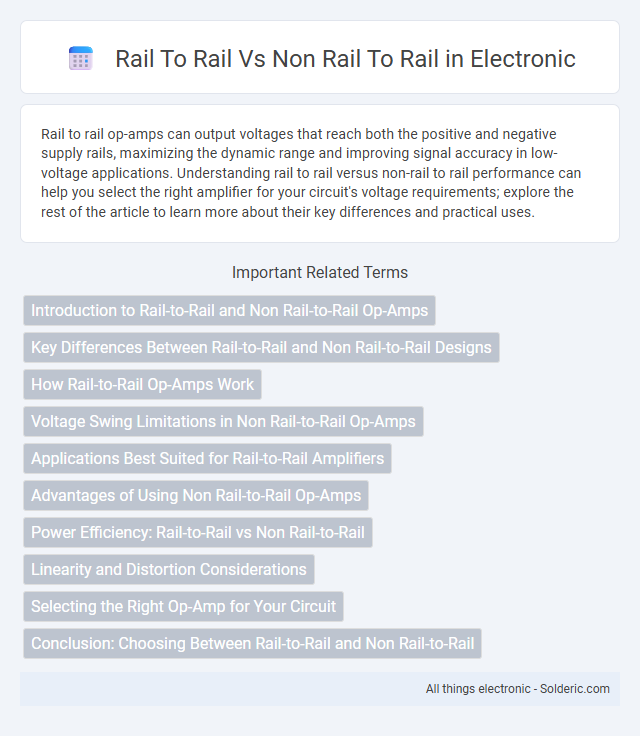Rail to rail op-amps can output voltages that reach both the positive and negative supply rails, maximizing the dynamic range and improving signal accuracy in low-voltage applications. Understanding rail to rail versus non-rail to rail performance can help you select the right amplifier for your circuit's voltage requirements; explore the rest of the article to learn more about their key differences and practical uses.
Comparison Table
| Feature | Rail to Rail | Non Rail to Rail |
|---|---|---|
| Input Voltage Range | Extends to supply rails (e.g., 0V to Vcc) | Limited; cannot reach supply rails |
| Output Voltage Range | Output swings full supply voltage range | Output limited, cannot reach rails |
| Application | Battery-powered and low-voltage circuits | General-purpose where full range not required |
| Design Complexity | More complex internal design | Simpler design |
| Power Consumption | Typically higher due to rail-to-rail stages | Lower power in some designs |
| Cost | Generally higher | Generally lower |
| Performance | Better dynamic range and signal handling at rails | Limited dynamic range near rails |
Introduction to Rail-to-Rail and Non Rail-to-Rail Op-Amps
Rail-to-rail op-amps offer input and output voltage ranges that extend close to the supply rails, enabling maximum dynamic range in low-voltage applications. Non rail-to-rail op-amps have limited input and output voltage swing, restricting signal processing near the power supply limits. Choosing the appropriate op-amp for your circuit design ensures optimal performance, especially in battery-powered or low-voltage systems.
Key Differences Between Rail-to-Rail and Non Rail-to-Rail Designs
Rail-to-rail operational amplifiers provide the capability to swing their input and output voltages close to the supply rails, enabling maximum dynamic range in low-voltage applications. Non rail-to-rail designs have limited input and output voltage ranges, which may restrict performance in battery-powered or low-voltage circuits. Your choice impacts signal integrity and power efficiency, especially in precision analog signal processing where maximizing voltage range is crucial.
How Rail-to-Rail Op-Amps Work
Rail-to-rail operational amplifiers (op-amps) are designed to amplify input signals that approach the supply voltage rails, allowing output voltages to swing very close to the power supply limits. These op-amps achieve this by using specialized input stage architectures, such as complementary differential pairs, to maintain proper operation even when the input voltage nears either rail. Your circuits benefit from improved signal range and efficiency, especially in low-voltage applications, making rail-to-rail op-amps ideal for battery-powered and precision analog designs.
Voltage Swing Limitations in Non Rail-to-Rail Op-Amps
Non rail-to-rail op-amps have limited voltage swing, typically restricted to a few volts below the supply rails due to their internal transistor configurations, which prevents the output from reaching the exact power supply limits. This voltage swing limitation reduces their suitability for low-voltage or single-supply applications where maximizing output range is critical. In contrast, rail-to-rail op-amps employ input and output stage designs that allow the output voltage to swing very close to the supply rails, optimizing signal range and dynamic performance.
Applications Best Suited for Rail-to-Rail Amplifiers
Rail-to-rail amplifiers excel in battery-powered and low-voltage applications such as portable medical devices, sensor interfaces, and data acquisition systems requiring full input and output voltage swing. These amplifiers are ideal for precision measurement circuits and instrumentation where maximizing dynamic range and accuracy at supply voltages close to the signal range is critical. In contrast, non rail-to-rail amplifiers are better suited for higher voltage systems with less stringent input-output swing requirements.
Advantages of Using Non Rail-to-Rail Op-Amps
Non rail-to-rail op-amps generally offer higher precision, lower noise, and superior linearity compared to rail-to-rail counterparts, making them ideal for applications requiring exceptional signal integrity. Their input and output voltage ranges are centered around mid-supply, allowing optimized performance in low-noise, high-accuracy measurement systems. These op-amps also typically consume less quiescent current, enhancing efficiency in battery-powered or low-power devices.
Power Efficiency: Rail-to-Rail vs Non Rail-to-Rail
Rail-to-rail operational amplifiers maximize power efficiency by enabling input and output signals to swing fully between the supply rails, reducing the need for additional voltage overhead and minimizing power consumption. Non rail-to-rail amplifiers require larger voltage headroom, limiting signal range and potentially increasing power dissipation due to higher quiescent currents. Choosing rail-to-rail devices optimizes Your circuit's power efficiency, especially in low-voltage and battery-powered applications.
Linearity and Distortion Considerations
Rail-to-rail operational amplifiers exhibit improved linearity by maintaining consistent performance across the entire input and output voltage range, reducing distortion in low-voltage applications. Non-rail-to-rail amplifiers typically suffer from increased distortion near the supply rails due to limited input/output swing, negatively impacting signal fidelity. Selecting a rail-to-rail op-amp ensures your design achieves minimal harmonic distortion and enhanced accuracy throughout its full voltage range.
Selecting the Right Op-Amp for Your Circuit
Choosing between rail-to-rail and non-rail-to-rail op-amps significantly impacts your circuit's performance, especially in low-voltage applications where input and output voltage ranges are critical. Rail-to-rail op-amps provide maximum input and output swings near the supply rails, improving signal fidelity and dynamic range in battery-powered or single-supply designs. Understanding these voltage requirements ensures you select an op-amp that maintains linearity and accuracy within your specific circuit constraints.
Conclusion: Choosing Between Rail-to-Rail and Non Rail-to-Rail
Choosing between rail-to-rail and non rail-to-rail op-amps depends on the application's input and output voltage requirements. Rail-to-rail op-amps offer maximum dynamic range by allowing input and output signals to swing fully from the negative to positive supply rails, ideal for low-voltage or single-supply designs. Non rail-to-rail op-amps may provide better noise performance and linearity within restricted voltage ranges, making them suitable for precision analog circuits where rail-to-rail operation is not essential.
Rail to rail vs Non rail to rail Infographic

 solderic.com
solderic.com